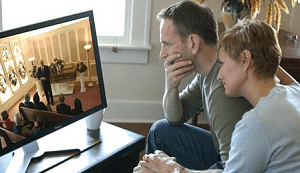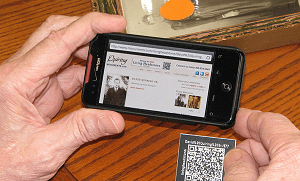We have been in the throes of a digital revolution for some time now, and it has slowly crept into a once very stoic funeral industry. Progressive funeral homes have seen the opportunity to embrace digital culture and technology and how it can enhance their business offering.
Over twenty years ago, when we first launched US Funerals Online, many funeral homes did NOT have a website. Many funeral directors still believed that ‘traditional’ methods of marketing were the only way for funeral homes and that people would not use the Internet to search for funeral services. How times have changed in the last two decades!
Frequently, we now find that funeral homes DO have a website. In fact, they may have more than one. Those that are embracing technology will have visually engaging, informative, and interactive sites. Many are now further utilizing all the Internet has to offer with additional online advertising, online directory listings, pay-per-click advertising, and participating in social networking campaigns.
So what can we expect from a funeral home in the digital age?
The ‘Virtual’ Funeral – Webcasting & live streaming of funeral services.

We have become a more dispersed and transient society, so the ability to stream funeral services and therefore enable distant family and friends to participate without extensive travel is a significant way that technology will change the funeral industry.
The costs to travel across the United States, let alone internationally, prevent many people from attending the funeral of a deceased family member or friend. Add to this constraints for time off work, tightened restrictions on travel, and economic impacts, and yes, more people today have to politely excuse themselves from attending services.
The COVID pandemic had a radical impact on this, highlighting the need for funeral streaming and virtual memorial services when families were unable to even gather locally at a funeral home. We all accepted the notion of ‘Zoom Funerals’ and more funeral homes invested in the technology.
We are also now such a visual culture, with nearly 60% of Americans indicating that they watch digitally streamed TV programming on a device and 78% of baby boomers being online (according to a study by ThirdAge). This means there is a greater acceptance, and a greater level of access, for people to participate in live web streaming of funeral services.
There still seems to be some discomfort in our culture with the notion of live web streaming of funerals. Is it distasteful? Does it remove us from the immersion in the funeral ritual and the grieving process?
Personally, I would argue that there are pros and cons to this new technology. I thought Evan Selinger’s post on Huffington Post about his experience of an online funeral in the wake of Hurricane Sandy made for an interesting exposition of how technology impacts us culturally.
We are widely accepting of dignitaries and celebrities having funerals streamed online or on TV, so why not for the masses?

So how does live web streaming of a funeral work?
In layman’s terms, video equipment is set up to video the funeral service, linked to a computer and software that enables the video to be live-streamed. In most cases the webcast is password-protected, so only family and friends provided with the password can access the streaming.
The webcast remains online for 30 days in order that family and friends who could not participate in the live stream can watch it, or people can re-visit the ceremony. Service Corporation International (SCI) has added webcasting at a number of their Dignity Memorial locations, and webcasting companies report a slow but steady uptake of the technology.
FuneralOne, which offers its ‘Life Tributes’ package to funeral homes across the U.S., saw the number of funeral homes offering webcasts increase from 126 in 2008 to 1,053 by 2010, clearly demonstrating the uptake of this technology.
According to Gather, 64% of funeral homes webcast or live stream every single funeral service they conduct.
Arranging a funeral or cremation entirely online – no funeral home visit required!
Webcasting may still be something of a marginal ancillary service, but we are also witnessing another aspect of how funerals are now offered online. More funeral homes and cremation companies are offering the ability to plan and arrange services ALL online, without ever visiting the funeral home.
This online service is frequently offered for those who wish to arrange a direct cremation service or a basic funeral. There are also cremation and funeral companies that facilitate the preplanning of a funeral using an online portal.
This ability to arrange a cremation, whether at need or preplanning, without ever stepping foot into a funeral establishment is probably the most significant way that funeral arrangement has been impacted by technology.
It has enabled many funeral businesses to offer direct cremation services at a reduced cost as it eliminates human resources in the time taken for a member of staff to conduct a family arrangement meeting.
It has also enabled funeral service providers to extend their ‘reach’ to cremation consumers. Especially as we are a nation of online shoppers, so why should funeral services not be purchasable online?
It is reported that 92% of Baby Boomers partake in Ecommerce today.
Obituaries, Online Memorials, and the Facebook Legacy
Newspaper obituaries are becoming somewhat obsolete as we all digest our media updates online. Online memorials are now common and are either offered by funeral homes as part of their service or can be purchased directly online from companies such as Tributes and Legacy.
Even more interesting is the advent of the life memorial many of us are now creating with our own Facebook page. It is likely that this legacy we self-build will again change the industry of online memorial sites.
‘Living Headstones’ – QR codes and monuments that have ‘playback.’

We are all becoming more familiar with those black and white squares adorning magazines, street signs, and coffee cups. QR codes (Quick Response) are starting to become embedded in our culture.
‘No contact’ and hygiene standards, especially during the pandemic, gave QR codes a whole new lease of purpose!
Cemetery markers have not really changed for centuries….until now…with the technology to be able to impregnate a QR chip into a grave marker. Now a detailed memorial of the deceased can be loaded onto a chip, set into a headstone, and accessed anywhere with a smartphone. This can metaphorically make a tombstone become a ‘living’ interactive memorial.
The examples above demonstrate how technology is reshaping the funeral landscape as we know it. As technology becomes more firmly embedded into our culture, I am sure we will see it revolutionize our death care rituals and our whole concept of death and memorialization.
Related Articles:

